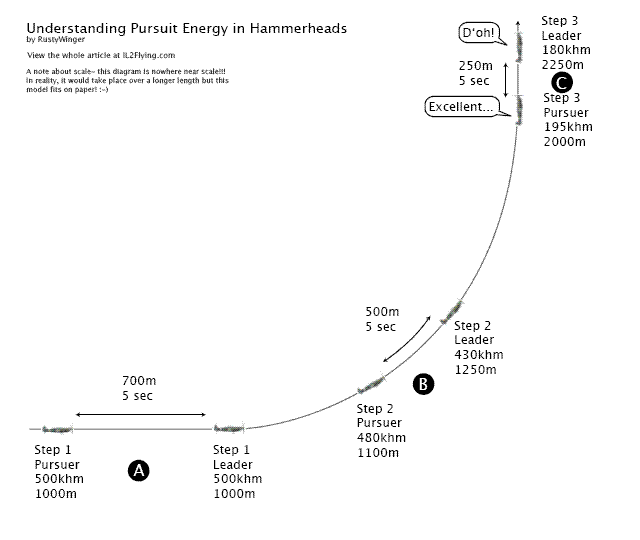|
Understanding Pursuit Energy in Hammerheads Author: RustyWinger Posted: 8/02/2004 originally at IL2flying.com. | << back to list of articles |
Introduction
How many times have you checked six to see that you are seemingly out of reach of a pursuer who is at about
the same speed/height as you, and decided to do a Hammerhead maneuver to turn things around - only to
discover you have badly miscalculated and you are now dead in the air within guns range? This is just
a short layman's explanation of the physics involved so you will have a better understanding of what
happens when you execute such a maneuver.
Dig out the Propeller hats!
Two equal planes moving at the same speed, for example, 500 kmh, are 5 seconds apart. This means it
takes the pursuer 5 seconds at 500 kmh to reach the point you were at 5 seconds ago. While you look back
and see the pursuer well out of guns range, that will change very quickly if you execute an energy-sapping
move such as a climb. As you climb, you will begin to lose energy and speed, which is part of your plan,
because, hey, he's out of guns range... you'll get to the top of this Hammerhead and he will still be out
of guns range, right? Wrong. If he took your exact line, he will still be 5 seconds behind you, yet well
in guns range and calmly picking your wings off.
Now wait a minute, you say - he was 5 seconds behind me and out of guns range while at the same speed before, how can he be shooting my ass off now? There are 2 reasons for this.
Reason #1
The distance between two objects traveling at 500 khm 5 seconds apart is about .70 km, or it takes 5
seconds to fly 700 meters. If you slow this down to 180 kmh - around stall speed - that distance covered
in 5 seconds becomes about .25 km, all that is needed at this point is a good aim.

Reason #2
Harder to calculate in terms of speed/distance due to variance, the pursuer may not follow your exact line of
flight, electing a lead pursuit approach (explained in detail elsewhere on IL2flying.com) meaning, basically,
he travels less distance than you to the same point in space which, combined with the gains realized by
your energy loss, he may have enough energy to actually do a guns pass on you before passing your inert
plane.

So when can I execute my Hammerhead?
1- When you have superior energy state. If you don't know if you have this, don't make the attempt until you have judged his energy state!
2- when you have superior height (note- a pursuer you have a height advantage over may have a speed advantage over you which might make them equal to you in energy state)
| --> RustyWinger // IL2flying.com | << back to list of articles |
